The Bank Emisyjny in Poland (Bank of Issue in Poland) was found on December 15, 1939 by the German occupying forces as central bank for the General Government(GG) in Krakow (Cracow). Its activity began on the April 8, 1940 with several branches on occupied territory. It was the only public institution using the name "Poland" in occupied country. The president was a Pole, Feliks Mlynarski, who had the approval of Polish social and economic
organizations. Despite the name it was totally under the occupying authority and the control of the German Commissar Fritz Paersch to continue German goals and policies. The bank issued banknotes known under the common name "Cracow's zloty" or "mlynarki"(Mlynarski note), after the name of the president. It issued two series of banknotes; the first dated March 1, 1940 with denominations; 1, 2, 5, 20, 50, 100, 500 zloty, and the second dated August 1, 1941 with denominations; 1, 2, 5, 50, 100 zloty. For a short period of time, in 1940, the bank validated Polish 100 zloty banknotes(issued in 1932 and 1934) by red overprint with German text: "Generalgouvrtnement fur die besetzten polnischen Gebiete".
Almost from the beginning occupied banknotes were counterfeited by the underground resistance movement, necessary to finance its activities. The first counterfeits of 1940-1942 were made by ZWZ(Zwiazek Walki Zbrojnej) and later by AK(Armia Krajowa -Home Army). Counterfeit banknotes were smuggled to the PWPW(Panstwowa Wytwornia Papierow Wartosciowych -States Printing House) and secretly exchanged for authentic ones. Later, counterfeit notes were classified as misprint and destroyed under German supervision.
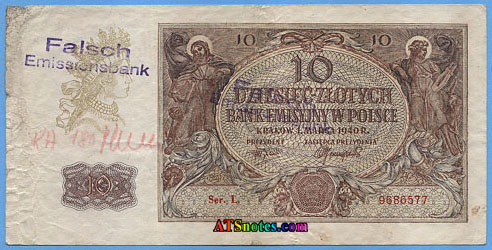 Picture #1. Counterfeit of 10 zloty from 1940.
Picture #1. Counterfeit of 10 zloty from 1940.
There was a huge amount of counterfeit banknotes with denomination 10, 20, 50, 100 zloty dated 1940, printed lithographic without distinctive watermarks. As on picture #1, the 10 zloty note has dozens fake matrix classified by the Germans. Most counterfeits were described and classified by specialists from the Bank Emisyjny. Counterfeited banknotes were stamped:"Falsch Emmissionbank", often including local stamp,
date, classification and number.
Classification of counterfeits were handwritten on the special rubber stamp: "Kl(klische -matrix)____Type___Z(zensor -censor)___".
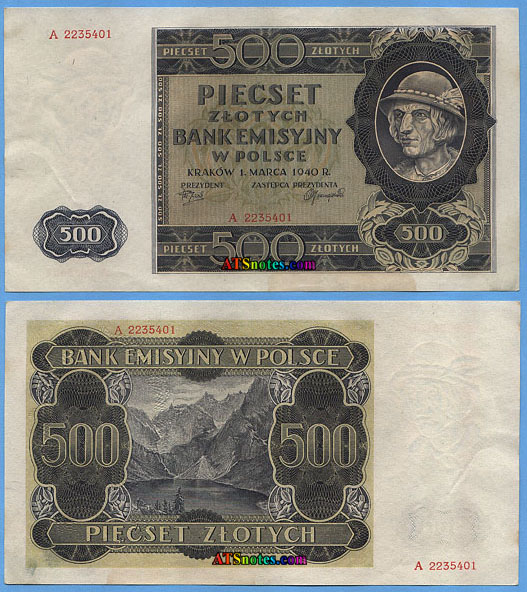 Picture #2. Banknote 500 zloty 1940, common nickname "mountaineer".
Picture #2. Banknote 500 zloty 1940, common nickname "mountaineer".
Only 3 banknotes had better protection against counterfeiting, using a distinctive watermarks on 50 zloty 1941, 100 zloty 1941, and 500 zloty 1940. The highest denominated banknote 500 zloty had a common nickname "mountaineer" from the picture of a mountaineer on the face and the Tatra Mountain with lake Morskie Oko on reverse (picture #2). It was the only banknote printed from a steel engraving plate and the watermark "mountaineer head". It was definitely the most difficult note to counterfeit and practically impossible to be made in an occupied country.
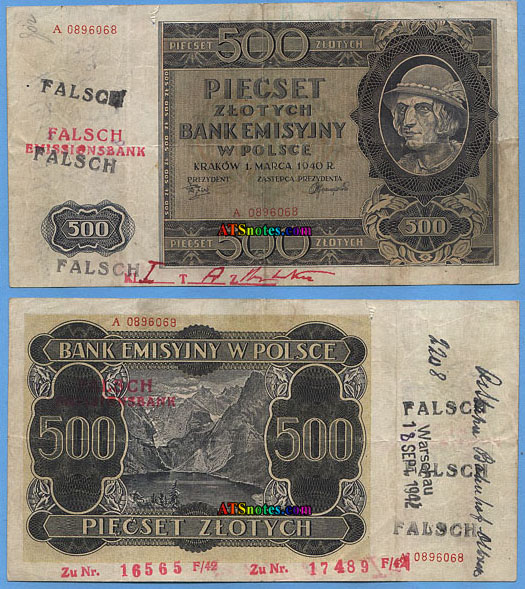 Picture #3. Counterfeited banknote recognized by Bank Emisyjny in Warsaw in 1942, classified matrix 1, type A ("Polish" type).
Picture #3. Counterfeited banknote recognized by Bank Emisyjny in Warsaw in 1942, classified matrix 1, type A ("Polish" type).
Forgery of 500 zloty, classified as from matrix 1, was most probably done only in Poland on relatively small scale in 1941-1943. Now this forgery is very rare, I have seen only one
banknote(pict.#3).
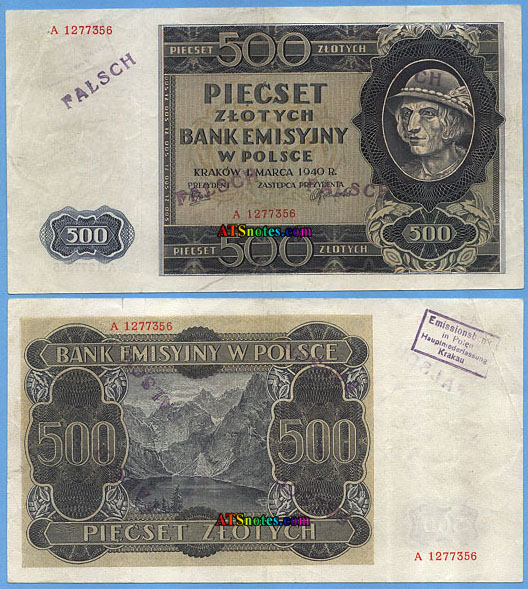 Picture #4. Counterfeited banknote with serial number "12" recognized by Bank Emisyjny in Krakow (matrix 2, type A "English" type).
Picture #4. Counterfeited banknote with serial number "12" recognized by Bank Emisyjny in Krakow (matrix 2, type A "English" type).
A very good forgery of the "mountaineer" was prepared and done in England under the order of Polish Government in Exile in London, most probably by the printing house Thomas de la Rue and Co.(pict.#4). Counterfeited banknotes were delivered to Poland by the RAF Air Force in 1944, when the Polish Resistance Movement needed a big amount of money to finance the
mobilization of the AK(Home Army), the biggest underground army in Europe. It was the beginning of strategic operations with cryptonym "Burza"(Storm), the target being the liberalization of Poland from German occupation before the encroaching by the Soviet Army. The detachments(squad) of the AK needed money for buying food, uniforms, medicine etc. from civilians. Confiscation was done only in German estates and warehouses.
Jozef Lubnicki(1), cryptonym "Wojna", quartermaster of Piotrkow AK recollected how the counterfeited "English" banknotes went into circulation. As quartermaster in 1944, he received around 15 millions zloty of notes counterfeited in England for supplies of his AK branch. Most of that amount were in denominations of 500 zloty and some in 100 zloty. The fake note 500 zloty were recognized, and not welcomed by civilian. The AK wished avoiding German repression against innocent people, so AK squads returned them back to the regional quartermaster Inspectorate. The Command of Piotrkow AK Inspectorate resolved this problem by using the bank in Piotrkow. Members of the resistance movement working at this branch exchanged around 100.000 zloty every day of counterfeited zloty for authentic ones. Nobody would check or ask question about the forged brand new banknotes received from the German bank. Good banknotes were returned to the Inspectorate and were distributed to AK squads. Till the end of August 1944 around 12 millions zloty were exchanged. However an audit by German specialists from the Bank Emisyjny in Krakow discovered a source from which counterfeits were distributed. Suspects were arrested and investigations were done.
There was a huge amount of questionable material. The high quality made it difficult to recognize counterfeits. All 500 zloty banknotes with the serial number starting with "12" or "13" were withdrawn from circulation because all of the "English" notes had serial numbers started in this way. Some of them were stamped and distributed to the Bank Branches in General Government as examples of counterfeit, the rest were destroyed. The forgery was classified as matrix 2 type A, now, those notes are rare.
Most probably there were only 2 trials of counterfeiting the "mountaineer", but only the "English" edition (matrix 2) supplied a big amount of good "quality" fake banknotes. This English counterfeit is worthy of notice, because it was the biggest forgery and caused the Bank Emisyjny to loose heavily. It was very accurately produced and not easy to recognize. There is a possibility that both governments, Polish in Exile and Great Britain were involved in this action.
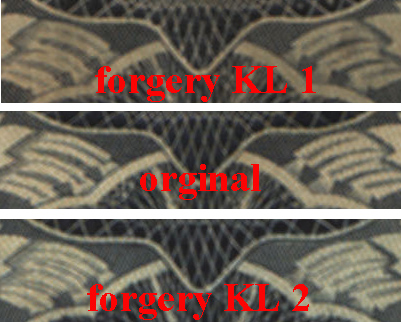 Picture #5. Comparison of "ears" detail from original with 2 types forgeries KL1(matrix 1 "Polish" type) and KL2(matrix 2 "English" type).
Here are some details to recognize counterfeited "mountaineers" KL2(matrix 2, "English" type)
Picture #5. Comparison of "ears" detail from original with 2 types forgeries KL1(matrix 1 "Polish" type) and KL2(matrix 2 "English" type).
Here are some details to recognize counterfeited "mountaineers" KL2(matrix 2, "English" type)
;
- Obverse(face): -details in steel engraving plate for example:
- "ears" above number 500 in the lower right corner(pict.#5)
- - original -hatched
- - forgery -empty
- very small details of the head of mountaineer.
- Reveres(back):
- -original -guilloche clear, dark
- -forgery -guilloche less clear, brighter
- paper:
- -original -white, little grayish
- -forgery -bright white, slender
- watermark:
- -original -clear, hat width 32mm
- -forgery -less clear, hat width 34mm
- numbers:
- -forgery -serial number starting with "12" or"13" small difference in the shape of numbers fonts
Financial effects.
Comparison of conquered financial sources by Polish underground resistance movement from a few operations:
- Counterfeiting money in PWPW(States Printing House) 1940-1942;
-18 millions zloty(with respect to 4,000 millions zloty in circulation in GG in 1942 -0.5%)
- Robbery of Bank Emisyjny armored car in Warsaw on August 12, 1943(action took only 2 minutes):
-106 millions zloty(with respect to 5,000 millions zloty in circulation in GG in 1943 -2%)
- The circulation of the "English" counterfeited 500 zloty in only one Inspectorate AK in Piotrkow, August 1944:
-15 millions zloty(with respect to 7,500 millions zloty in circulation in GG in 1944 -0.2%)
The author welcomes hearing from anyone who may have any additional information regarding these issues, please e-mail: ats@atsnotes.com
(1) Dariusz Golebiowski, "Burza nad Czarna" MON 1972.
home -
glossary, grading etc. -
ordering -
help Q&A
© Copyright 1996-2022 ATSnotes.




